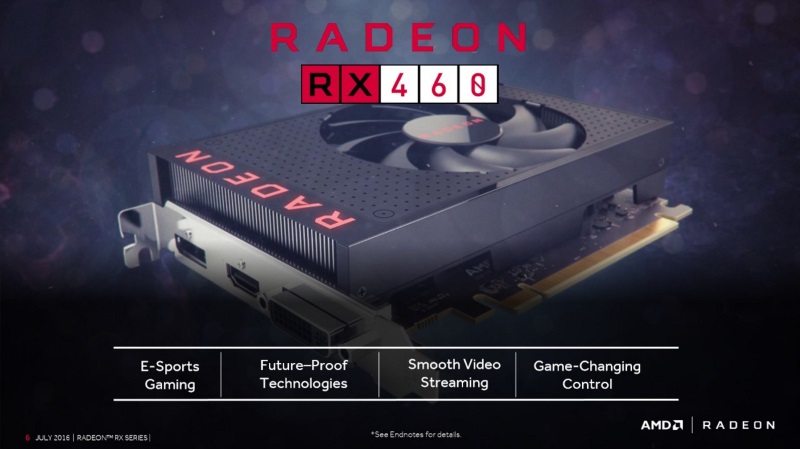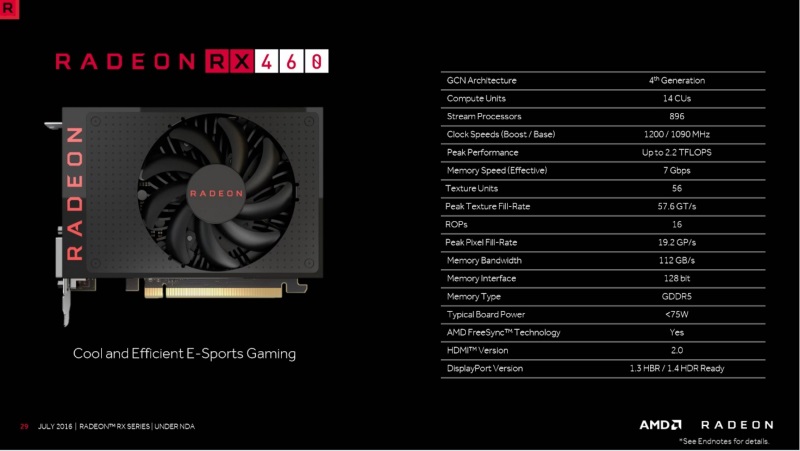
Just days after making the Radeon RX 470 officially available, AMD has released its smaller sibling, the Radeon RX 460. Graphics cards based on this new GPU will be available in phases, with 2GB models hitting markets from the 15th of August onwards and 4GB versions in early September. AMD’s suggested retail prices for India are Rs. 11,990 for 2GB cards and Rs. 13,490 for 4GB cards, however board partners will set their own pricing and are likely to offer models with custom fans and circuitry at somewhat higher prices.
Unlike the RX 470 and RX 480 before it which are both based on the Polaris-10 GPU design with different amounts of resources enabled in hardware, the new Radeon RX 460 uses a smaller chip called Polaris-11. As a result, Radeon RX 460 cards do not need any auxilliary power connectors and can run on nothing more than the 75W provided by any motherboard. Radeon RX 460 cards from board partners including Asus, MSI, XFX, Gigabyte and Sapphire are expected to have smaller coolers and be able to fit comfortably into small-form-factor PCs.
AMD is targeting the bottom of the graphics card market with this launch, in particular e-sports enthusiasts and gaming cafe owners who won’t be running today’s most demanding 3D games. The company claims excellent performance at 1920×1080 in titles such as Leage of Legends, Overwatch, Rocket League, CS:GO and DOTA 2. Performance can generally be expected to be on the level of today’s most popular game consoles, but at an entry-level price. Radeon RX 460 cards would also be suitable as drop-in upgrades for pre-built PCs which don’t have power supplies capable of supporting higher-end cards.
 The Radeon RX 460 GPU is made up of 896 programmable “stream processor” units running at up to 1200MHz. Cards will have either 2GB or 4GB of GDDR5 RAM on a 128-bit bus. Total compute power is rated at 2.2 Teraflops. AMD is also touting support for the emerging DirectX 12 and Vulkan programming APIs which allow game developers to eliminate driver overheads and squeeze more performance out of hardware than before, as well as High Dynamic Range (HDR) video output.
The Radeon RX 460 GPU is made up of 896 programmable “stream processor” units running at up to 1200MHz. Cards will have either 2GB or 4GB of GDDR5 RAM on a 128-bit bus. Total compute power is rated at 2.2 Teraflops. AMD is also touting support for the emerging DirectX 12 and Vulkan programming APIs which allow game developers to eliminate driver overheads and squeeze more performance out of hardware than before, as well as High Dynamic Range (HDR) video output.
AMD’s emphasis with this generation of GPUs has been to target the 84 percent of buyers who will spend only up to $300 (approximately Rs. 20,000 before taxes and duties) on a graphics card, rather than chasing absolute performance benchmarks. In doing so, it has ceded the high ground to rival Nvidia, which has introduced several GPUs priced at between $249 and $1200 in the past few months. The Nvidia GeForce GTX 1060, GTX 1070, GTX 1080 and new Titan X have all targeted enthusiasts who play at resolutions up to 4K.
[“source-ndtv”]







